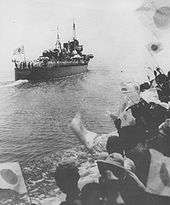Japanese destroyer Hamakaze (1940)
Hamakaze (浜風, "Beach Wind") was one of 19 Kagerō-class destroyers built for the Imperial Japanese Navy during the 1930s.
 Hamakaze underway on 30 June 1941 | |
| History | |
|---|---|
| Name: | Hamakaze |
| Ordered: | 1937 |
| Laid down: | 20 November 1939 |
| Launched: | 25 November 1940 |
| Commissioned: | 30 June 1941 |
| Stricken: | 10 June 1945 |
| Fate: | Sunk in action, 7 April 1945 |
| General characteristics | |
| Class and type: | Kagerō-class destroyer |
| Displacement: | 2,490 long tons (2,530 t) |
| Length: | 118.5 m (388 ft 9 in) |
| Beam: | 10.8 m (35 ft 5 in) |
| Draft: | 3.8 m (12 ft 6 in) |
| Propulsion: | Two-shaft geared turbines |
| Speed: | 35 knots (40 mph; 65 km/h) |
| Range: | 8338km (4500nm) |
| Complement: | 240 |
| Armament: |
|
Design and description
The Kagerō class was an enlarged and improved version of the preceding Asashio class. Their crew numbered 240 officers and enlisted men. The ships measured 118.5 meters (388 ft 9 in) overall, with a beam of 10.8 meters (35 ft 5 in) and a draft of 3.76 meters (12 ft 4 in).[1] They displaced 2,065 metric tons (2,032 long tons) at standard load and 2,529 metric tons (2,489 long tons) at deep load.[2] The ships had two Kampon geared steam turbines, each driving one propeller shaft, using steam provided by three Kampon water-tube boilers. The turbines were rated at a total of 52,000 shaft horsepower (39,000 kW) for a designed speed of 35 knots (65 km/h; 40 mph). The ships had a range of 5,000 nautical miles (9,300 km; 5,800 mi) at a speed of 18 knots (33 km/h; 21 mph).[3]
The main armament of the Kagerō class consisted of six Type 3 127-millimeter (5.0 in) guns in three twin-gun turrets, one superfiring pair aft and one turret forward of the superstructure. They were built with four Type 96 25-millimeter (1.0 in) anti-aircraft guns in two twin-gun mounts, but more of these guns were added over the course of the war. The ships were also armed with eight 610-millimeter (24.0 in) torpedo tubes for the oxygen-fueled Type 93 "Long Lance" torpedo in two quadruple traversing mounts; one reload was carried for each tube.[2] Their anti-submarine weapons comprised 16 depth charges.[3]
Construction and career

Hamakaze was heavily involved in the fighting in 1943 in the Solomon Islands chain, including the battles of Kula Gulf, Kolombangara, and the 'Battle off Horaniu'. On 7 April 1945, Hamakaze escorted the battleship Yamato from the Inland Sea on her Operation Ten-Go attack on the Allied forces on Okinawa. She was sunk by aircraft of Task Force 58 and sank 150 miles (240 km) southwest of Nagasaki (30°47′N 128°08′E).[4]
Notes
- Chesneau, p. 194
- Whitley, pp. 200–01
- Jentschura, Jung & Mickel, p. 148
- Spurr, Russell (1981). A Glorious Way To Die - The Kamikaze Mission of the Battleship Yamato. New York: Newmarket Press. pp. 257. ISBN 9781557049131.
References
- Chesneau, Roger, ed. (1980). Conway's All the World's Fighting Ships 1922–1946. Greenwich, UK: Conway Maritime Press. ISBN 0-85177-146-7.
- Jentschura, Hansgeorg; Jung, Dieter & Mickel, Peter (1977). Warships of the Imperial Japanese Navy, 1869–1945. Annapolis, Maryland: United States Naval Institute. ISBN 0-87021-893-X.
- Whitley, M. J. (1988). Destroyers of World War 2. Annapolis, Maryland: Naval Institute Press. ISBN 0-87021-326-1.